
Kabardians
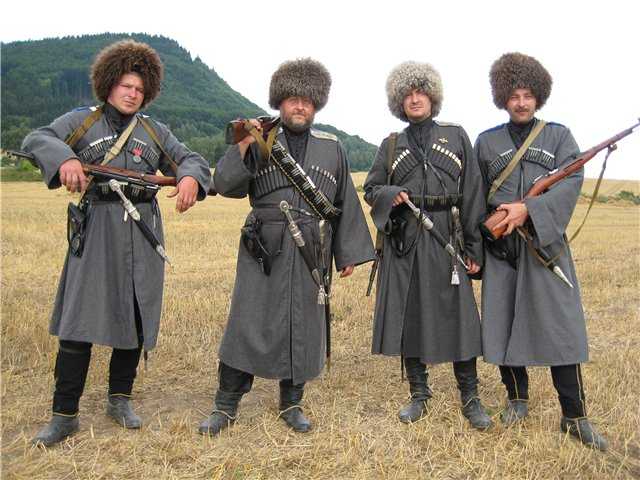
The Kabardians (or Kabardins) are a large tribe speaking a Caucasian language from what is now Kabardino-Balkaria (the Balkars are a neighbouring Turkic speaking tribe). The Kabardians are mostly Moslem, with a few Christian ones in Ossetia. They are one of the tribes sometimes grouped under the term "Circassian".
1st and 2nd Kabardian Horse Regiments
The Imperial Army formed a Kabardian Regiment in the Savage Division, and we have assumed that the RCW units kept this basic uniform (admittedly without any great evidence).
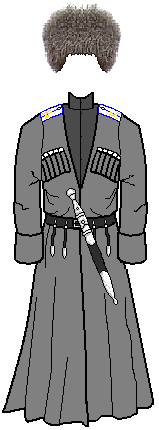 |
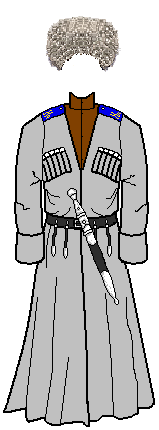 |
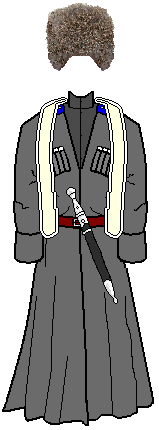 |
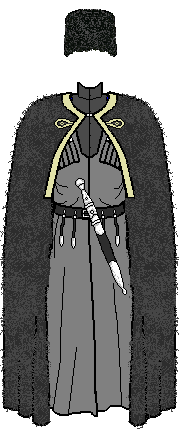 |
| Officer: Kabardian Horse Regiment |
Trooper: Kabardian Horse Regiment | Trooper with bashlyk | Trooper with burka |
Uniform Details
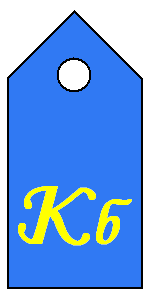 |
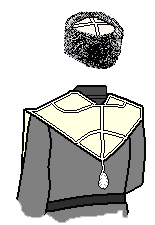 |
| Shoulderboard: Kabardian private | Dress bashlyk and officer's hat, ivory with white piping |
Details on the Kabardians are light. The Savage Division unit had light blue shoulderboards, and "white" bashlyks, which probably weren't pure white in practice. Officer lace was silver, so rank markings for cavalry were in gold. Khaki shoulderboards were marked in light blue.
History in the RCW
The 1st and 2nd Kabardian Horse Regiments were formed when the Terek started to organise against the Bolsheviks in mid- 1918. In September they entered the 1st Native Horse Division, which formed part of Colonel Shkuro's command. (The rest of the division were the 2nd and 3rd Circassian Regiments, the Karachay Regiment and an Ossetian Divizion.)
In late 1918 the Kabardians split off to became a Separate Kabardian Horse Brigade, which in March 1919 formed part of the Combined Mountain Division. This fought as part of the Forces of the North Caucasus, as the AFSR drove towards Astrakhan.
The 3rd and 4th Kabardian Horse Regiments were formed in February 1919. They joined the 1st and 2nd Regiments, and the 2nd Horse Artillery Divizion, to form the Kabardian Horse Division in September (or perhaps before).
In October 1919 the bulk of the division was sent to the Caucasian Army. While called a division, it wasn't very large.
Division Commander – Maj-Gen. Bekovich-Cherkasskiy
1st Kabardian Horse Regiment – Col. Anufriev – 140 sabres
2nd Kabardian Horse Regiment – Col. Leus – 35 sabres
3rd Kabardian Horse Regiment – Col. Krapotkin – 62 sabres, 3 MGs
4th Kabardian Horse Regiment – Col. Khodzinskiy – 40 sabres
2nd Horse Artillery Divizion – Maj-Gen. Fok
1st Horse Battery – 2 light cannons
2nd Horse Howitzer Battery – 1 howitzer
5th Horse Battery – 1 light cannon
The small 5th and 6th Kabardian Horse Regiments and two training commands were still in the Forces of the North Caucasus.
All the Kabardian units were formally broken up in May 1920, but were likely defunct some time before that.
Similar Units
Kabardian
The 4th Circassian Regiment of the Circassian Horse Division was Kabardian. This may have been a Cherkes unit, since they speak a language related to Kabardian.
Some Kabardians made it to the Crimea, where the 1st Native Cavalry Regiment was briefly formed in April 1920. After being moved around a couple of times, it was broken up in August 1920 and the horses sent to the 1st Cavalry Division. It is possible that a squadron or two of one of this division's component cavalry regiments was Kabardian.
During the Civil War the AFSR also included the reformed 80th Kabardian Infantry Regiment, based on officers from the Imperial unit of that name. We believe this was a normal infantry unit, and not composed of mountaineers.
Other
The light blue and white colour scheme of the Kabardians is very similar to that of the 2nd Dagestani Horse Regiment, discussed on its own page.
Flags
The WWI Kabardian Horse had had been awarded a Nikolai (in the non-Christian variant without the slogan and the icon) but it was never delivered.
The modern flag of Kabardino-Balkaria is this:
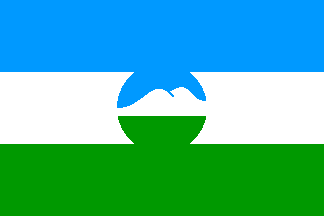
A photo of the period (see photo page) seems to show something with an Islamic crescent and star theme, known to have been used at the time, inside a tricolour. Combining the modern colours with that symbol, we get:
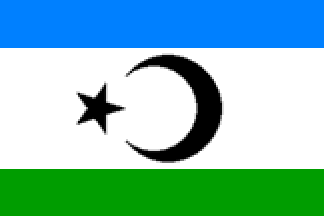
Photos
We have collected various period photos of mountaineers on a separate page.